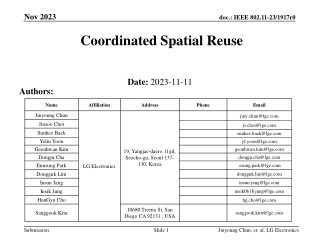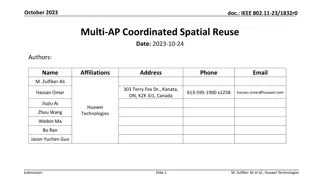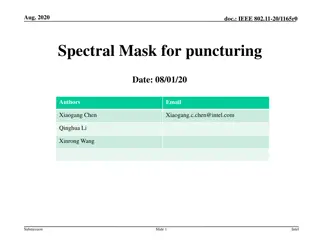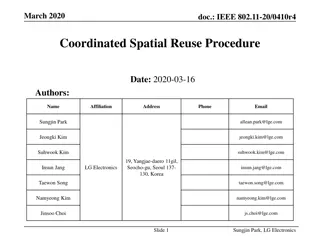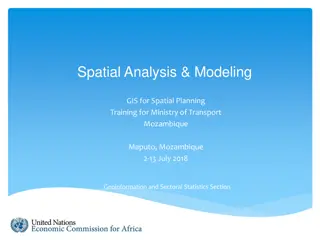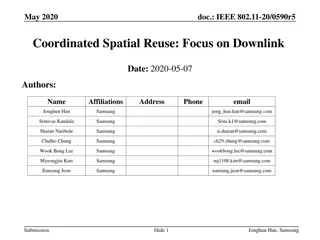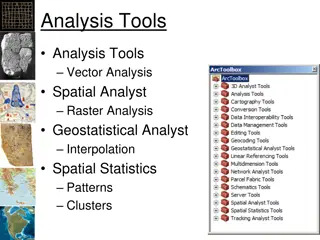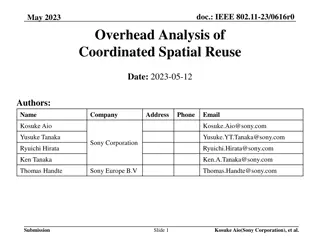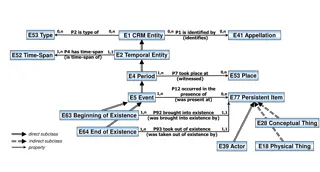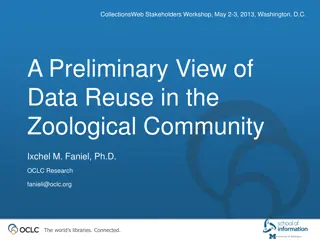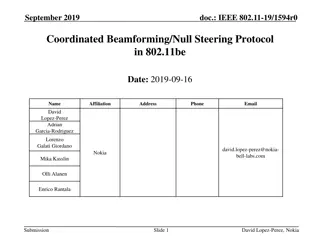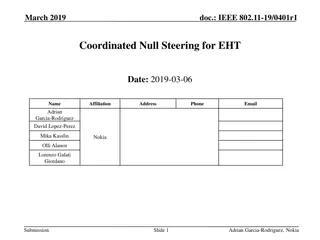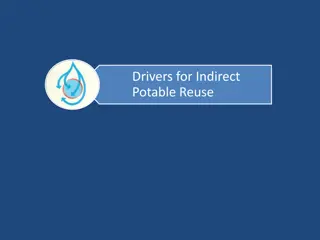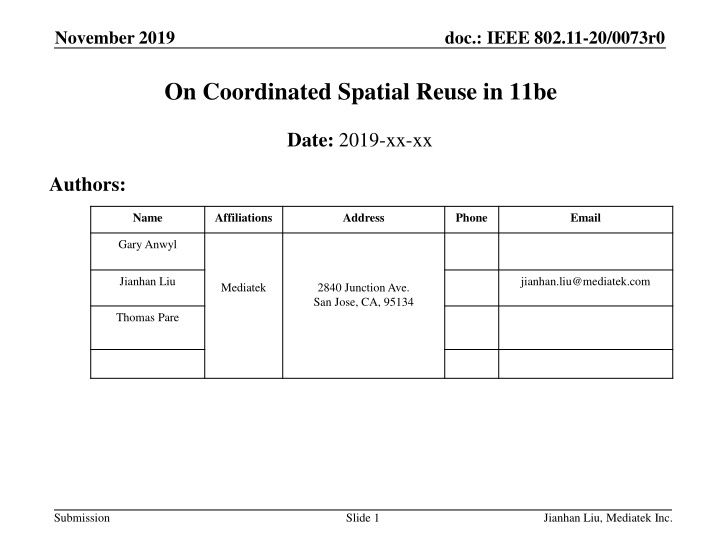
Coordinated Spatial Reuse in IEEE 802.11be for Multi-AP Systems
Explore coordinated spatial reuse (CSR) in IEEE 802.11be for multi-AP systems where different access points (APs) transmit to nearby stations (STAs) to improve network throughput. The CSR approach involves coordinated power control among APs, enhancing performance without requiring complete CSI or extensive synchronization. Learn about the benefits of CSR, performance analysis, and simulation modes for maximizing network efficiency in this technological domain.
Download Presentation

Please find below an Image/Link to download the presentation.
The content on the website is provided AS IS for your information and personal use only. It may not be sold, licensed, or shared on other websites without obtaining consent from the author. If you encounter any issues during the download, it is possible that the publisher has removed the file from their server.
You are allowed to download the files provided on this website for personal or commercial use, subject to the condition that they are used lawfully. All files are the property of their respective owners.
The content on the website is provided AS IS for your information and personal use only. It may not be sold, licensed, or shared on other websites without obtaining consent from the author.
E N D
Presentation Transcript
November 2019 doc.: IEEE 802.11-20/0073r0 On Coordinated Spatial Reuse in 11be Date: 2019-xx-xx Authors: Name Affiliations Address Phone Email Gary Anwyl Jianhan Liu jianhan.liu@mediatek.com Mediatek 2840 Junction Ave. San Jose, CA, 95134 Thomas Pare Submission Slide 1 Jianhan Liu, Mediatek Inc.
November 2019 doc.: IEEE 802.11-20/0073r0 Coordinated Spatial Reuse (CSR) Spatial Reuse makes a lot of sense in coordinated multi-AP systems Different AP can transmit to STAs that are close to itself. Coordinated Power Control benefits the multi-AP BSSs Note that the fundamental difference from spatial reuse with OBSS in HE is that spatial reuse in EHT are within one network. Temporarily reduce power for one AP or one STA to increase the network throughput benefits every one in the network including itself. Coordinated Spatial Reuse (CSR) is one of the Coordinated Multi-AP modes considered for 11be 11-19-1534-00-00be Coordinated Spatial Reuse Performance Analysis 11-19-0801-00-00be AP Coordination in EHT Simpler than Coordinated Beamforming and Joint Beamforming Doesn't require complete CSI between all APs and STAs Doesn't require rigorous synchronization among APs Only path loss information might be needed Submission Slide 2 Jianhan Liu, Mediatek Inc.
September 2019 doc.: IEEE 802.11-20/0073r0 Coordinated Spatial Reuse Diagram APs coordinated transmit power to reduce interference and increase total throughput AP1 AP2 STA2 STA1 Two Cents to think about CSR: 1. If there are leakages in CBF due to channel estimation error or channel aging, it automatically behaves like CSR. 2.The protocols used for CBF can be directly used for CSR. Submission Slide 3 Jianhan Liu, Mediatek Inc.
Xxxx 2019 doc.: IEEE 802.11-20/0073r0 Multi-AP Simulation Modes Coordinated OFDMA (C-OFDMA) - Each AP TXs in a different 20M RU Spatial Reuse (SR) All APs transmit simultaneously at full power Coordinated Spatial Reuse with TPC (CSR) - Exhaustive search to select Transmit Power Control (TPC) for each AP that maximizes sum goodput. MCS and TPC selection is based on path loss for all AP-STA combinations 11ax OBSS_PD Spatial Reuse (SR 11ax) 11ax OBSS_PD. First AP sends at full power. Each additional AP sends with OBSS_PD TPC based on AP-AP path loss Simulation Sequence Performance metric is the Sum of the Goodput of each AP-STA pair For each STA use CSI to calculate RX signal from own AP and interference from each OBSS AP. Include thermal noise floor. Compute RBIR SINR based on per subcarrier signal and interference Use RBIR SINR to estimate PER for each MCS Estimate Goodput based on selected MCS and estimated PER Submission Slide 4 xxx, xxxx
Xxxx 2019 doc.: IEEE 802.11-20/0073r0 11ax OBSS PD settings STA measures RX OBSS_PD_level for OBSS then jointly lowers TX level and raises PD level in order to TX Parameters OBSS_PD_min = -82dBm OBSS_PD_max = -62 dBm Nominal TX = +21 dBm For OBSS_PD_level in range -82..-62 reduce Tx power by (-82- OBSS_PD_level) up to 20 dB Submission Slide 5 xxx, xxxx
Xxxx 2019 doc.: IEEE 802.11-20/0073r0 Simulation Configurations Setup Configuration 2 AP-AP distance=30m, BSS Radius=15m 30m Loss = 83 dB, RSSI = -62 dBm TPC = -20 dB Four APs Randomly drop one STA in each BSS Tx power = +21 dBm TGn Path Loss Model D-NLOS channel AP1 AP2 AP3 AP4 BSS Radius AP-AP Distance Submission Slide 6 xxx, xxxx
Xxxx 2019 doc.: IEEE 802.11-20/0073r0 Results of Configuration 2 Submission Slide 7 xxx, xxxx
Xxxx 2019 doc.: IEEE 802.11-20/0073r0 Additional Configurations Configuration 3 Same as Config 2 except BSS Radius=50m Same Loss and TPC as Config 2 Configuration 4 Dynamic Point Select (reassign STAs to minimize sum distances) Configuration 5 STAs is in same quadrant as AP AP1 AP2 AP3 AP4 BSS Radius AP-AP Distance Submission Slide 8 xxx, xxxx
Xxxx 2019 Configuration 3 (BSS Radius=50m) doc.: IEEE 802.11-20/0073r0 Left: CDF of Sum Goodput C-OFDMA is not maximum Right: CDF of Active APs CSR: 60% One AP, 35% Two APs, 5% Three APs, 0% Four APs Submission Slide 9 xxx, xxxx
Xxxx 2019 doc.: IEEE 802.11-20/0073r0 Configuration 4 (DPS) Left: CDF of Sum Goodput C-OFDMA is not maximum Right: CDF of Active APs CSR: 30% One AP, 60% Two APs, 10% Three APs, 0% Four APs Submission Slide 10 xxx, xxxx
Xxxx 2019 Configuration 5 (STA in same Quadrant) doc.: IEEE 802.11-20/0073r0 Left: CDF of Sum Goodput C-OFDMA is not maximum Right: CDF of Active APs CSR: 20% One AP, 60% Two APs, 18% Three APs, 2% Four APs Submission Slide 11 xxx, xxxx
November 2019 doc.: IEEE 802.11-20/0073r0 Summary CSR has significant performance gain compared to a Coordinated OFDMA and 11ax OBSS PD based spatial reuse in most scenarios. CSR with TPC only needs Path Loss of other APs CSI of other APs are not required: much less sounding and feedback overhead. CSR achieves very good trade-off on complexity and performance. CSR can be implemented with the similar protocols defined for CBF. Submission Slide 12 Jianhan Liu, Mediatek Inc.
November 2019 doc.: IEEE 802.11-20/0073r0 Straw Poll #1 Do you agree to add support of Coordinated Spatial Reuse (CSR) in 11be multi-AP system? Submission Slide 13 xxx, xxxx

